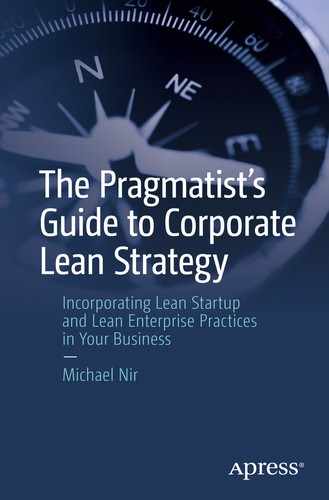You’ve spent the first 30 days invested in the lean program. Half of your time was dedicated to defining the vision, a quarter was spent training the leadership team, and the remainder was divided among creating an outside-in mindset, preparing for experiments, and ideating potential pivot opportunities. You might have already identified the stakeholders supporting the program and your adversaries.
Time Spent on Activities–First 90 Days
Activity | Time Spent | Comments |
|---|---|---|
Define vision | 25% | Popularize with stakeholders and gain commitment |
Identify customer personas | 20% | Facilitate persona focus through direct engagement with the consumer |
Prototype MVP and program training | 25% | Train mid-level management |
Run experiments | 20% | Coach team to experiment with customers |
Pivot or persevere | 10% | Create the safety nets; pivot from failed initial MVP results |
Develop Vision
The vision that you’ve well articulated in the first 30 days is still limited. As mentioned, the organization’s leaders often assume that the vision is shared merely by the fact it has been created and communicated in a town hall. That couldn’t be further from the truth. Usually the vision is still nebulous in minds of both the leadership team and the organization at large. Other forces see the vision of an overarching framework that is designed to deliver value as threatening their fiefdoms. In traditional silo organizational structures, middle managers see the overarching integration of existing frameworks as invading on their authority. This holds true even for so-called agile development organizations that push back on a holistic lean engine, claiming it to be an interruption to their ongoing delivery cycle. It is also true for UX experts and designers who under the false pretense of Lean UX prefer to focus on creating complete designs without the business orientation that is driven by the lean engine. Six Sigma professionals who often focus on the quality aspect of delivery view the integrated model as belittling their quality-driven efforts.
These adversarial stakeholders are unaccepting and in disagreement with the program objective and employ manipulative means to propagate disagreement. This group is the most difficult to influence.
That said, others in the organization support the vision and understand the need for an integrative model that is united by a lean engine driven by consumer validation.
The onerous task of building enough support for the program consumes a quarter of the program’s effort in the first 90 days. Following the stakeholder attitude analysis that was completed in the first 30 days, you direct your attention to building the support for the program.
Your challenge, though, is focusing on the supporters rather than the adversaries. That runs counter-intuitive to how we normally build support. Often we invest time and effort to build trust and agreement with opposing stakeholders. Practically, these might be wasted efforts, leading to the opposite result. The focus on this group develops into an openly hostile conflict that resonates with the other stakeholder groups and can create a landslide in the overall level of support.1 That is not to say that you should totally ignore the adversarial group of stakeholders; rather, be cognizant to the fact that we often focus on them rather than lead the fence-sitters.
Anti-Pattern
Why do we focus on the adversary group? Psychologically speaking, we have a need to be accepted and loved (or at least liked), and we find it extremely difficult to be in a position where people are unaccepting of us. We go to great lengths to receive appreciation and support from groups of people who disagree with us and/or our goals.
As a general rule of thumb, in any interaction that you might have, approximately 5% of the stakeholders will be against, 5% of the stakeholders will be in favor, and the remaining 90% of stakeholders will be either fence sitters or paying some amount of lip service.
—Michael Nir2
Focus the efforts on the stakeholders who support the vision and promote it with those who are still wavering, the fence sitters. Share the success stories with the entire organization, yet avoid investing time and effort by trying to convince opposing stakeholders.
Consider a Silicon Valley-based integrated circuit engineering and manufacturing company that was facing a prominent decline in market share due to changing usage patterns among consumers. The leadership embraced the lean unifying framework, articulated a vision, and participated in the executive training. While support for the program was in place among marketing, finance, and software engineering, I identified resistance with the hardware engineering, operations, and regional sales business units. The deeper analysis did confirm that the senior vice presidents of the opposing business units viewed the program suspiciously; some were more in line with the vision than others. Building on the CEO’s support for the program, I enlisted a high-profile program team to act on the ideas that emerged from the executive workshop. The cross-functional team had members of the supporting business units as well as some members of the adversarial business units. I had to work with this team in the first 90 days to identify customer personas, prototype an MVP, and run experiments with customers to validate their hypotheses.
Since at this point a few of the senior vice presidents opposing the program were taking a passive role, I saw the opportunity to find members of their organization that were supporting the effort. This required me to continue identifying support for the vision as I was learning the realities of the business. I used the learning to persuade mid-level managers in the business units of the adversarial senior vice presidents to support the program. The five cross-functional teams that emerged from the first executive training had a mix of supporters and a few fence sitters. By the completion of the 90-day program and the demonstration of successful results, I had gained momentum and sufficient buy-in to proceed to the next phase.
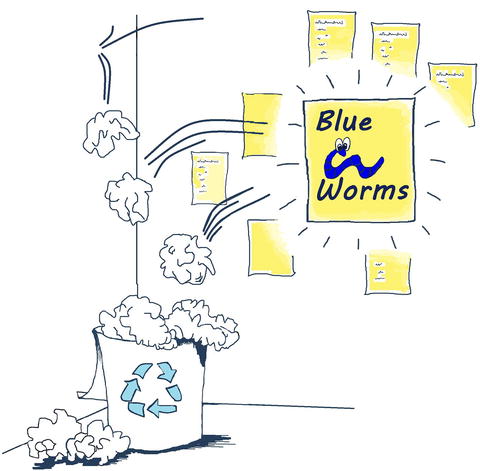
Many ideas exist and our goal is to provide a framework to quickly test and pivot or persevere. (Source: Graphic design by Hen Nir. © Sapir Consulting US LLC 2017, www.michaelnir.com )
Best Practice
The first teams emerging from the executive training self-select projects on which they will implement the lean approach. I prefer that they select project/product/feature/opportunities; however, I rarely limit them and often this can result in non-product related ideas. Thus, leaders identify huge undertakings that the organization has been struggling with for some time. The art and skill of this step is to identify a meaningful MVP that can be validated in 90 days and create a marked impact on the business. When non-product ideas are selected, the resulting 90-day MVP might be the validation of the removal of non-necessary process steps, which in itself is a win.
Identify Customer Personas
More effort is required during the first 90 days in developing personas. Let’s revisit what you learned previously: in many organizations, personas are treated as a sign of being “modern.” Pictures are laminated on the wall and persona stories are included in employee booklets. However, personas should be as living and breathing as the people who they represent. Creating static types of your users and customers is counterproductive because it represents a point in time rather than allowing the persona to evolve with your thinking. Thus, consider personas as continuously evolving, much as the customer persona evolves along with a company’s understanding of the target audience and their needs.
Anti-Pattern
I view the lofty laminated persona pictures and associated details on the walls as you enter the main offices of a corporation as another case of bad smell. For me it is a sign of misinterpretation of the concept. When persona creation is a onetime effort usually led by user interface and user experience experts, the results are a superficial understanding of the consumer.
Go see; ask why; show respect.
—Fujio Cho, Toyota chairman
Treat the creation of a persona as a learning process in itself. Follow up with the five cross-functional teams that completed the training and coach them to validate their assumptions about the persona they drafted during the executive training. A recurring pattern is that the organizations are often convinced that their assumptions about their consumers are true; however, once researched, many of these assumptions prove to be false.
As mentioned, big organizations and corporations are frequently characterized by little interaction with customers both internal and external. Use the first 90 days to challenge the prevailing organizational mindset that “we aren’t allowed to interact with consumers.” Ask the teams to clearly state the assumption about the draft persona and push back on their inclination to use existing internal data to validate it. Rather, request that they validate their assumptions by interacting directly with real people outside the offices, in the real world. For executive teams that hardly ever interact with a consumer, this is a quite a challenge. They usually bring up various legal and compliance excuses to push back; however, this is just a smokescreen masking their fear of actually going out of the building and validating their assumptions. When I tasked executive teams with validating their assumptions concerning the personas they created with real consumers, they often hid behind surveys and regulations.
Anti-Pattern
Teams in organizations that rarely reach out to their consumers tend to blame it on various legal and regulatory restrictions. While some may be true, most of the excuses are actually a disguise for an innate fear of reaching out to consumers and getting unfiltered feedback about the products and services. This fear is evident and possibly justified in legacy industries where consumers are captured audiences.
The goal of the first 90 days is to break the fear and empower the teams to validate their assumptions concerning the draft persona they created. This is an initial step in the creation of a living persona. I will revisit the topic in the next chapter.

A graphic captures the main attributes, experiences, thoughts, and feelings of the persona. (Source: Graphic design by Hen Nir. © Sapir Consulting US LLC 2017, www.michaelnir.com )
Tip
What if the consumer is an internal customer? Some of the ideas stemming from the training sessions will eventually lead to creating an internal persona. That’s fine; in many organizations employees in one business unit are oblivious to the impacts of their decisions on a downstream business unit. Therefore identifying a persona for an internal customer makes sense and is useful in clarifying any assumptions concerning them.
The best example of the gap between the laminated, colorful, synthetic persona exhibited on the corporate office walls and the real, flesh-and-blood consumer occurred in the offices of a private health insurance provider in London. The laminated persona was a smiling, 60-year-old city dweller who was engaged in sports and the community, led a healthy life, and yet suffered from a certain chronic disease. There were numerous details concerning his lifestyle, dwelling, fears, and concerns. However, the persona didn’t convey the true essence of the consumer; rather it conveyed a cheerful disposition. When I conducted a user-centered design workshop with the executive team working through their persona assumptions, a different and starker persona appeared, one that allowed a much deeper appreciation of who the consumer was. It was similar to upgrading from a flat two-dimensional view to a three-dimensional view. The wall-mounted persona models could not capture the key feeling and experiences of the persona and thus contributed to a skewed perception of the possible solution.
Tip
Remember the microwave example from the introduction? What if you created a rudimentary cardboard prototype of a microwave and used it at a local mall to interact with an unfiltered, non-persona-specific population. What might you learn?
Prototype MVP and Program Training
The training program that commenced with the executive team proceeds with training targeted to mid-level management. The goal of the first 90 days is to have approximately 3-5% of the employees trained. Considering a reasonably sized enterprise of 10,000 to 20,000 employees, this translates to roughly 500 to 1,000 mid-level managers trained. Each class holds about 25 participants grouped in five predefined cross-functional teams of five individuals each. On average, you can expect to run several dozens of these classes.
Best Practice
Does this mean that you should embark on a hiring spree before you roll out the program? Not necessarily. I found that the members of the PMO, Scrum Masters, UX experts, and others in various backgrounds that have the right mindset serve well as trainers and coaches to the program, in addition to targeted hiring for trainers.
By the end of the first month, you should have identified and trained internal regional trainers to facilitate the program. Each of these trainers will then become a mentor and coach for the teams they train, supporting them weekly in getting them prepared for their separate 90-day demonstrations. I suggest that you schedule demonstrations regionally with members of the executive leadership participating in person to review the results of the MVP validations.
Pre-workshop individual assignments
Workshop: Two-day, hands-on, experiential workshop
Workshop first evening reflection
Workshop team assignment
Team post-workshop activity
Team lean startup coaching
Team exhibition
Each trainer-made coach supports up to six classes worth of participants, thus they need to be fully engaged and committed to the program. The weekly coaching session are scheduled for 30 minutes, hence about half their time is committed to these sessions.
Tip
I was hesitant whether to present the full program details for the enterprise, since it might instill some concern with readers who do not command the organizational resources to set a plan such as this in motion. However, I wanted to detail a comprehensive approach to enterprise success; I have implemented smaller scale efforts with much success. Actually, you could start with 6 teams, 4 or even a single team to validate assuumptions and demostrate the results!
The MVPs are defined by each team during the training; the goal of each team is to identify the assumption that will be validated by the MVP. That’s challenging because the team is unsure what the MVP should look like. Often the first coaching sessions are spent refining the MVP and brainstorming which assumptions must be validated.

Facts and assumption about the persona emerge from the MVP. (Source: Graphic design by Hen Nir. © Sapir Consulting US LLC 2017, www.michaelnir.com )
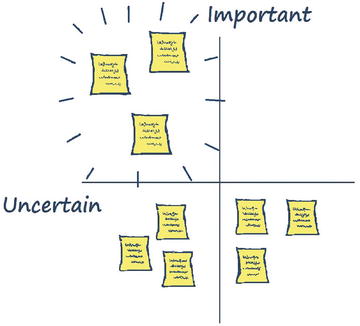
The facts and assumption grid (Source: Graphic design by Hen Nir. © Sapir Consulting US LLC 2017, www.michaelnir.com )
Tip
Do teams self-select ideas for projects or are those driven by the executive team’s ideas? I struggled with this question for quite some time. There are benefits for both approaches. On the one hand, allowing the teams self-select ideas for projects conveys a message of empowerment: you are giving the employees control of their destiny, you are sending a clear message that you welcome their contribution to the vision, and you trust them to come up with the ideas that would make the most sense for them. On the other hand, you expose yourself to the danger of having ideas that don’t really impact the organization from the perspective of the overarching vision and some of the ideas are mediocre. I have seen both occur and yet most often stayed the course of allowing each team a control of its own destiny, assuming that top-down controlled planning of ideas would not necessarily lead to better results. I’ll let you be the judge and decider on how to approach the topic.
Run Experiments with Customers to Validate Your Hypotheses
The sense of urgency is on; you must run experiments with your consumers to validate the assumptions that the teams identified. There is little that stands in your way to accomplish this, apart from the resistance that the teams themselves exhibit. The fear of getting out of the comfort zone and asking for direct feedback on their ideas, assumptions, and hypotheses is not something they were ever training to perform. The best method to overcome this resistance is to coach the teams, post the two-day training, to start experimenting with the customer immediately without letting the fear sink in. The learnings from the simplest of experimentation are vast. The teams I coach often discover that they crafted the wrong hypotheses or that the hypotheses were quickly refuted. Once they start, they get excited since they are receiving unfiltered feedback to their idea, something that for most is a revelation.
Tip
The unfiltered learning that occurs at this phase in the first 90 days is nothing short of mind-blowing. The ideas that the executive team selects and are validated shortly provide initial answers to long-time questions that the enterprise has been implicitly struggling with. Make sure you capture the discoveries and share them with the wider organization to grow the support for the program.

Lean startup workshop (validation planning) (Source: Graphic design by Hen Nir. © Sapir Consulting US LLC 2017, www.michaelnir.com )
The Lean Engine Description
Hypothesize: As early as the first day of the workshop, explain the importance of clearly stating a hypothesis. By the second day, the participants are prepped to think about the assumption they have concerning their idea in the context of a hypothesis. The difference between an assumption and a hypothesis is the measurability. We might assume that chickens will eat blue worms. However, the hypothesis is numerical and measurable: if we offer 10 chickens four dietary options , then at least 5 of them will eat the blue worm because they agree with this type of food.
Plan: How are you validating the hypothesis? Who will you engage? How would you find them? What would you need for that? The plan answers these questions and more. We recruited Ross and gave him a light blue bib and silverware. We placed a blue worm in front of him to observe his dietary preferences.
- A full plan will discuss the following:
Objectives: What is the goal of the validation?
Approach: How to validate?
Consumer participants: With whom to validate?
Agenda: What is the flow of the validation session?
Environment: Where to validate?
Plan: What is the overall timeline to validate?
- Part of the validation plan is to search for the candidates. There are various sources:
Friends and family: Simple and cheap for initial and quick validation. Make sure these aren’t you closest friends and family members because they might refrain from the feedback you need.
Research firm: Expensive and yet offers the most flexible and widest reach.
Social media: Effective and rather cheap. Allows a medium reach, although it requires a network to operate on.
Ad hoc: When you need really fast responses to short questions, you can validate at your office, the next-door company, the mall, or your favorite coffee shop. That’s exactly what gemba is all about.
- There are various methods to quickly mock up and prototype an MVP without investing in any upfront software or hardware development. Consider the following:
Concierge MVP: Identify valuable MVP elements and perform them manually.
Wizard of Oz: Behind the curtain you operate the functions either manually or via existing product and technology.
Dry Wallet: Measure price point, for example, by offering a dummy “purchase now” option.
Video: Video of “real life” scenario to validate interest.
Crowdsourcing: Similar to dry wallet; however it’s a faster, anonymous roll out to validate interest.
Define the metrics: At the same time that you plan for the validation, you identify the metrics you will use to assess the results of the validation. It is true that you initially discuss the metrics as you craft the hypothesis; however, you often need to break it down and further detail it. I introduced the concept of vanity metrics in Chapter 5. You need to identify metrics that matter. I also differentiated between output-outcome-impact metrics. Effective MVP validation is done by focusing on outcome and impact metrics. What if Ross doesn’t peck the worm? Is this a success?
- More on metrics…
- The One Metric That Matters (OMTM) is a metric that
Provides a clear answer to your questions
Drives focus on the objective
Speeds the build-measure-learn cycle
- An effective metric is
A ratio rather than an absolute number (new sales per hour)
Simple, such as revenue per time unit or product
Comparative, relevant for A/B testing
Metrics evolve through the program. The metrics for validating a problem are different than the metrics for validating a solution and for validating a MVP and ongoing feature hypothesis validation. While the former are measured qualitatively and often done through interviewing, the latter are measured quantitatively and are described as profit or savings ratios.
Tip
Following the microwave example, what would the elements of a plan to validate look like?
Pivot or Persevere in a Build-Measure-Learn Cycle
A few pivots occur in the first 90 days, and you need to support the process of learning and failing. As mentioned, a pivot is a result of a hypothesis being invalidated, which means that the original assumption was wrong. The failing part is difficult to accept, especially if the assumption has been one that the organization believed in for a long time. Additionally, for members of the executive team, accepting that they were wrong is sometimes difficult to acknowledge.
Best Practice
An assumption can be broken down into one or more hypotheses. In case of an assumption being broken into many hypotheses, make sure you aren’t claiming the whole assumption is wrong when only a subset of its hypotheses were invalidated.
Framing the failure as part of an ongoing build-measure-learn cycle assists in accepting the failure as part of the learning. This cycle is at the heart of lean thinking in the enterprise . The build-measure-learn cycle questions the concept of “big bang” deliveries, which dominated development and project management for a long time. Big bang approaches became prevalent in the past as organizations grew in size and distanced themselves from consumers, products increased in complexity, mass production and mass marketing ruled, and assembly lines spanned continents. We lost sight of the need to build, get feedback from customers by measuring, learning, and then iterating based on the learning. The agile software movement that officially started with the Agile Manifesto in 2001 was a catalyst towards iterative development. It was both a driver and a response to the market demand for product personalization, getting software products to market faster, and aligning the product to the actual needs of the consumer. There is some criticism about the fast iterative feedback approach in the sense that it prohibits monumental undertakings and limits the development to small improvements.3 However, the criticism doesn’t answer the problems of the remarkable waste occurring in the creation of results .
Figure 8-6 illustrates the concept of a pivot resulting from a build-measure-learn cycle. The build process has to be as small as possible, hence the concepts of MVP; the measurement has to measure the outcome. Notice that in this case, Ross the rooster didn’t ask for a progress report of twigs per square foot from the IT department or for a status report of hours invested to build the nest from Operations . He measures an outcome by interacting with the actual build; he sits in the MVP nest to validate fit-for-use. Unfortunately, the hypothesis is invalidated and the MVP assumption fails. Ross falls down. Was a safety cushion provided for him to fall into? When implementing a build-measure-learn cycle, you need to make sure you address the safety nets protecting the company in case of failures. Part of the first 90 days is learning and putting in place such safety nets .
Best Practice
Address the issue of safety nets early on. Identify and formulize the required mechanisms that allow the safety of failure and communicate broadly, so employees aren’t surprised. Communicate that failure is an option.
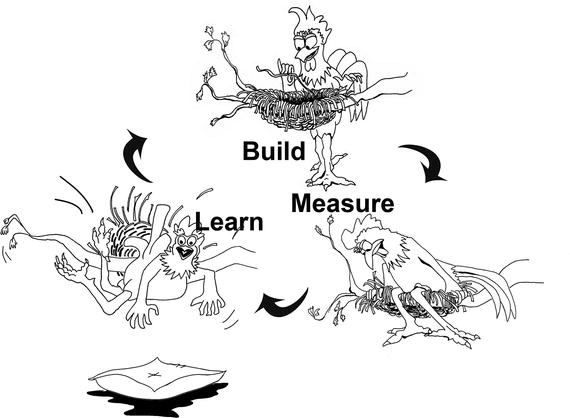
Build-measure-learn cycle (pivot) (Source: Graphic design by Hen Nir. © Sapir Consulting US LLC 2017, www.michaelnir.com )
What happens when there are no safety nets in place? Consider a financial services enterprise that adopted lean thinking to speed the integration and deployment of a back-end core system to replace an obsolete legacy system. It was a revolutionary approach because it focused on an internal core system. Traditionally, replacements of legacy systems and deployment of new IT core systems are lengthy projects , often costly, and normally under deliver on the promised results.
The team was using the build-measure-learn cycle to cut down the requirements gathering process, remove exceptions, and speed the time to deploy. They identified an MVP for a new product and created the required mechanisms to support the purchase, use, and support capabilities on the new system. They spent several months constructing the minimal core functionalities. Prior to the launch, they met with the various business owners and asked them for the possible impacts of various scenarios. The operations team and the manager of the consumer representative organization estimated that the impacts of the MVP would be minimal. No special plans were put in place in case things went wrong. Based on this, they decided to roll out the new MVP functionality across all of the lower 48 states (US).
The day after launch, vital signs showed a small increase in waiting times at the call centers. Two days later, the waiting times were doubled. By day three, the average wait time for a customer representative quadrupled. It was less than a week before urgent meetings started to appear on calendars. Executives were called in, the program was halted, and fall-back scenarios discussed. As is the case in enterprises , finger pointing started and blame was assigned. It didn’t matter that the senior vice president of operations estimated small impact prior to the go-live. Now his business unit was paying for the additional hours and days of work, and he was outraged. The program lost credibility and the term “MVP” was ridiculed. At this point, they decided to roll back the deployment and deploy the solution state by state, which is a fundamental concept of MVP deployment. On top of which no safety nets were in place.
Tip
Discuss the various options for the MVP from a business perspective; there are many degrees of freedom to limit the impact of validating gone wrong. Always communicate your intentions.
The hypothesis can also be validated, in which case the company perseveres. It proceeds with the next most important and most uncertain assumption, validating the relevant hypothesis. Figure 8-7 illustrates the concept of persevering in a build-measure-learn cycle. The build process has to be as small as possible, hence the concept of MVP. The metrics must measure the outcome. Notice again that Ross the rooster didn’t ask for a forecast development effort from the enterprise PMO. By interacting with the actual build he measures an outcome; he sits in the MVP nest to validate fit-for-use. Ross then learns about the building process. Is the nest comfortable? Is it safe? Can it support his weight for a period of time ?
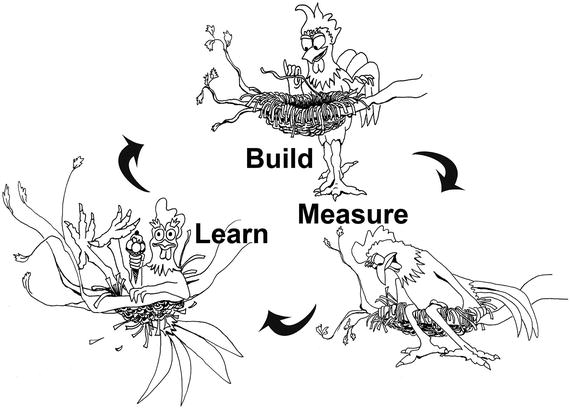
Build-measure-learn cycle (persevere) (Source: Graphic design by Hen Nir. © Sapir Consulting US LLC 2017, www.michaelnir.com )
Tip
What might be the various business options to limit the MVP in your organization?
